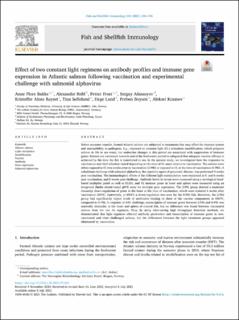Effect of two constant light regimens on antibody profiles and immune gene expression in Atlantic salmon following vaccination and experimental challenge with salmonid alphavirus
Bakke, Anne Flore; Rebl, Alexander; Frost, Petter; Afanasyev, Sergey; Røyset, Kristoffer Alnes; Søfteland, Tina; Lund, Hege; Boysen, Preben; Krasnov, Aleksei
Peer reviewed, Journal article
Published version
Permanent lenke
https://hdl.handle.net/11250/3006344Utgivelsesdato
2021Metadata
Vis full innførselSamlinger
Sammendrag
Before seawater transfer, farmed Atlantic salmon are subjected to treatments that may affect the immune system and susceptibility to pathogens. E.g., exposure to constant light (CL) stimulates smoltification, which prepares salmon to life in sea water, but endocrine changes in this period are associated with suppression of immune genes. Salmon are vaccinated towards end of the freshwater period to safeguard that adequate vaccine efficacy is achieved by the time the fish is transferred to sea. In the present study, we investigated how the responses to vaccination and viral infection varied depending on the time of CL onset relative to vaccination. The salmon were either exposed to CL two weeks prior to vaccination (2-PRI) or exposed to CL at the time of vaccination (0-PRI). A cohabitant challenge with salmonid alphavirus, the causative agent of pancreatic disease, was performed 9 weeks post vaccination. The immunological effects of the different light manipulation were examined at 0- and 6-weeks post vaccination, and 6 weeks post challenge. Antibody levels in serum were measured using a serological bead-based multiplex panel as well as ELISA, and 92 immune genes in heart and spleen were measured using an integrated fluidic circuit-based qPCR array for multiple gene expression. The 2-PRI group showed a moderate transcript down-regulation of genes in the heart at the time of vaccination, which were restored 6 weeks after vaccination (WPV). Conversely, at 6WPV a down-regulation was seen for the 0-PRI fish. Moreover, the 2-PRI group had significantly higher levels of antibodies binding to three of the vaccine components at 6WPV, compared to 0-PRI. In response to SAV challenge, transcription of immune genes between 2-PRI and 0-PRI was markedly dissimilar in the heart and spleen of control fish, but no difference was found between vaccinated salmon from the two CL regimens. Thus, by using labor-saving high throughput detection methods, we demonstrated that light regimens affected antibody production and transcription of immune genes in non-vaccinated and virus challenged salmon, but the differences between the light treatment groups appeared eliminated by vaccination.
